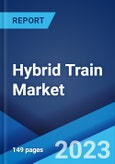Hybrid train is a locomotive transportation medium that is powered by an on-board rechargeable energy storage system (RESS), in combination with other fuel, such as diesel. They are located between power source and traction transmission system that are directly connected with wheels to promote smooth operations. They further use various energy storing devices, including supercapacitors, flywheels, and batteries, to sustain additional energy produced from regenerative braking. As compared to conventional fuel trains, hybrid trains are more reliable, emission-free, noise-free, cost-effective, and eco-friendly. At present, hybrid trains are commercially available in solar-powered, compressed natural gas (CNG), battery-operated, and electro-diesel propulsion types.
Hybrid Train Market Trends:
The widespread adoption of the hybrid train as a cost-effective, sustainable, and reliable mode of transportation can be attributed to the increasing scarcity of natural resources and the hiking fuel prices. This represents the key factor primarily driving the market growth. Furthermore, the emerging trend of green transportation solutions, along with the introduction of stringency policies by governments of various nations to promote the uptake of alternative fuel-powered trains, such as hybrid trains that meet the required emission and efficiency standards, are propelling the market growth. Conventional fuel-powered trains generate various hazardous gases, including nitrogen dioxide (NO) and carbon dioxide (CO2), which is responsible for causing various ecological and health issues. In line with this, freight companies are increasingly participating in frequent mergers and acquisitions (M&A) to collectively invest in hybrid trains, thus helping them in cutting down operating costs, including fuel and maintenance. Moreover, the incorporation of lithium-ion batteries in hybrid trains to ensure minimal power consumption, improved voltage capacity, longer charge retention is contributing to the market growth. Other factors, such as rapid urbanization, expansion in construction activities to strengthen transportation infrastructure, and increasing railway connectivity, are positively stimulating the market growth.Market Segmentation:
This report provides an analysis of the key trends in each segment of the global hybrid train market report, along with forecasts at the global, regional, and country levels from 2025-2033. The report categorizes the market based on propulsion type, operating speed, and application.Breakup by Propulsion Type:
- Electro-Diesel
- Battery Operated
- Hydrogen Powered
- Gas Powered
- Solar Powered
Breakup by Operating Speed:
- Below 100 Km/h
- 100-200 Km/h
- Above 200 Km/h
Breakup by Application:
- Passenger
- Freight
Breakup by Region:
- North America
- United States
- Canada
- Asia-Pacific
- China
- Japan
- India
- South Korea
- Australia
- Indonesia
- Others
- Europe
- Germany
- France
- United Kingdom
- Italy
- Spain
- Russia
- Others
- Latin America
- Brazil
- Mexico
- Others
- Middle East and Africa
Competitive Landscape:
The competitive landscape of the industry has also been examined along with the profiles of the key players being Alstom SA, Ballard Power Systems Inc., Construcciones y Auxiliar de Ferrocarriles, CRRC Corporation Limited, Hitachi Ltd., Rolls-Royce Holdings plc, Siemens AG, Stadler Rail AG, The Kinki Sharyo Co. Ltd., Toshiba Infrastructure Systems & Solutions Corporation and Vivarail Ltd.Key Questions Answered in This Report
1. How big is the hybrid train market?2. What is the future outlook of hybrid train market?
3. What are the key factors driving the hybrid train market?
4. Which region accounts for the largest hybrid train market share?
5. Which are the leading companies in the global hybrid train market?
Table of Contents
Companies Mentioned
- Alstom SA
- Ballard Power Systems Inc.
- Construcciones y Auxiliar de Ferrocarriles
- CRRC Corporation Limited
- Hitachi Ltd.
- Rolls-Royce Holdings plc
- Siemens AG
- Stadler Rail AG
- The Kinki Sharyo Co. Ltd.
- Toshiba Infrastructure Systems & Solutions Corporation
- Vivarail Ltd.
Table Information
| Report Attribute | Details |
|---|---|
| No. of Pages | 148 |
| Published | May 2025 |
| Forecast Period | 2024 - 2033 |
| Estimated Market Value ( USD | $ 15.8 Billion |
| Forecasted Market Value ( USD | $ 23.4 Billion |
| Compound Annual Growth Rate | 4.5% |
| Regions Covered | Global |
| No. of Companies Mentioned | 11 |








